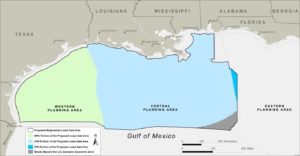BOEM holding public meetings on Draft Supplemental Environmental Impact Statement

The US Bureau of Ocean Energy Management (BOEM) has announced that it will hold public meetings to obtain comments regarding the Gulf of Mexico OCS Lease Sale: Draft Supplemental Environmental Impact Statement 2018. On 31 March, BOEM published the Notice of Availability of the 2018 BOM Draft Supplemental EIS for the proposed 2018 GOM lease sales, scheduled in the 2017-2022 Outer Continental Shelf Oil and Gas Leasing: Proposed Final Program.
These public meetings are held in an open-house format and may be attended between 4pm and 7pm CDT. The meetings are scheduled as follows:
- Pensacola, Florida: 1 May, Hilton Garden Inn Pensacola Airport, 1144 Airport Blvd, Pensacola, Florida, 32504;
- Mobile, Alabama: 2 May, The Admiral Hotel Mobile, Curio Collection by Hilton, 251 Government Street, Mobile, Alabama, 36602; and
- Gulfport, Mississippi: 3 May, Courtyard by Marriott, Gulfport Beachfront MS Hotel, 1600 East Beach Boulevard, Gulfport, Mississippi, 39501.
Public meetings were also held in New Orleans on 25 April and in Houston on 27 April.
Written comments on the 2018 GOM Draft Supplemental EIS must be submitted no later than 45 days following the publication date of the Notice of Availability in the Federal Register in one of the following ways:
- In an envelope labeled “Comments on the 2018 GOM Draft Supplemental EIS” and mailed or hand delivered to Greg Kozlowski, Deputy Regional Supervisor, Office of Environment (GM 623E), Bureau of Ocean Energy Management, Gulf of Mexico OCS Region, 1201 Elmwood Park Boulevard, New Orleans, Louisiana, 70123-2394; or
- Through the regulations.gov web portal: Navigate to http://www.regulations.gov and search for Docket No. BOEM-2017-0001. Click on the “Comment Now!” button to the right of the document link. Enter your information and comment, and then click “Submit.”
The 2018 GOM Draft Supplemental EIS provides an analysis of the potential significant impacts of a proposed action (a regionwide lease sale) and the reasonable alternatives to proposed action. This Supplemental EIS is expected to be used to inform decisions for each of the two proposed lease sales scheduled in 2018 and to be supplemented as necessary for future Gulf of Mexico regionwide lease sales. This Supplemental EIS tiers from and updates the Gulf of Mexico OCS Oil and Gas Lease Sales: 2017-2022; Gulf of Mexico Lease Sales 249, 250, 251, 252, 253, 254, 256, 257, 259, and 261; Final Environmental Impact Statement (2017-2022 GOM Multisale EIS).
The proposed oil and gas lease sales detailed in this Supplemental EIS are tentatively scheduled to be held in 2018 under the Five-Year Program. BOEM is proposing to offer for oil and gas leasing all available unleased blocks within the Western Planning Area (WPA), Central Planning Area (CPA), and Eastern Planning Area (EPA), with the exception of the whole and portions of blocks deferred by the Gulf of Mexico Security Act of 2006, blocks that are adjacent to or beyond the Eastern Gap, and the whole and partial blocks within the boundary of the Flower Garden Banks National Marine Sanctuary.
The proposed WPA lease sale area encompasses approximately 28.58 million acres. As of February 2017, approximately 25.9 million acres of the proposed WPA lease sale area are unleased. The proposed CPA lease sale area encompasses about 63 million acres of the total CPA area of 66.45 million acres. As of February 2017, approximately 49.2 million acres of the proposed CPA lease sale area are unleased. The proposed EPA lease sale area covers approximately 657,905 acres and includes those blocks previously included in the EPA Lease Sales 225 and 226 area, which is bordered by the CPA boundary on the west and the Military Mission line (86º41′ W longitude) on the east. The area is south of eastern Alabama and western Florida; the nearest point of land is 135 miles (201 km) northwest in Louisiana. As of February 2017, approximately 606,995 acres of the proposed EPA lease sale area are unleased.
Click here to download or view the 2018 GOM Draft Supplemental EIS on BOEM’s website.




